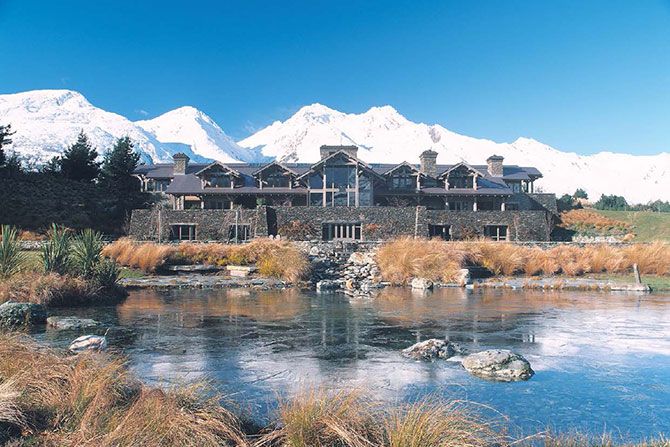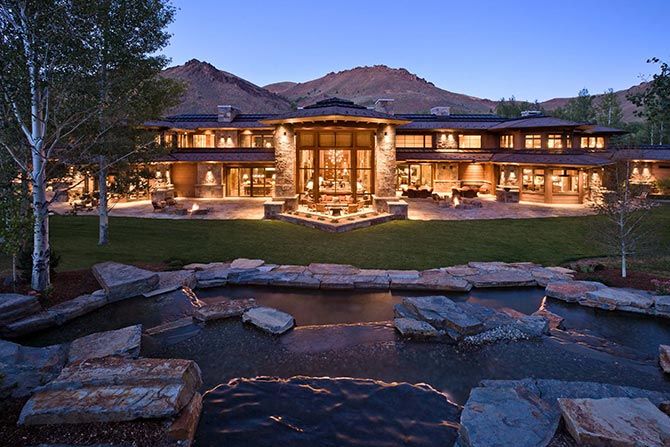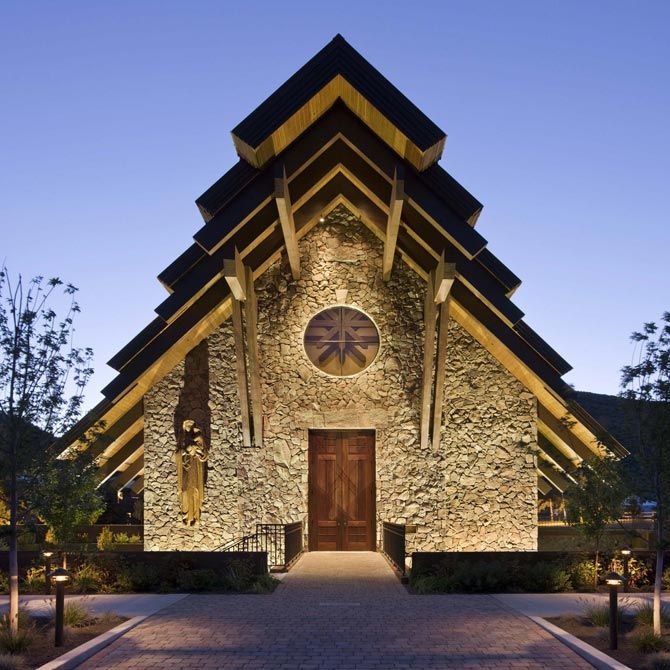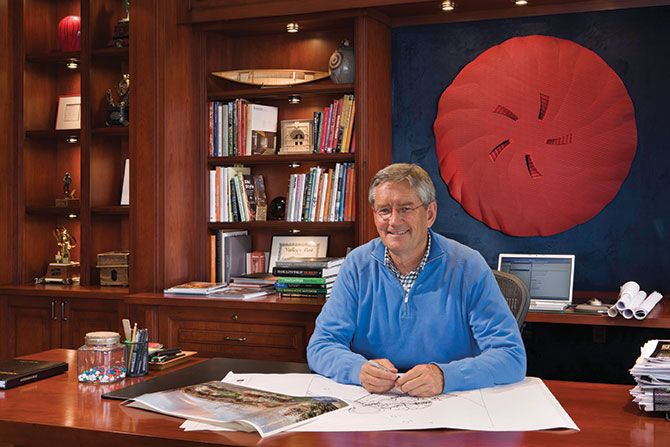In 1975, James “Jim” D. McLaughlin, AIA, founded McLaughlin and Associates Architects. From the beginning, the holistic design approach he takes with clients — through a highly collaborative process of design, review, revision and re-design — creates architecture that is not only sensitive to the functional and emotional needs of the users but also to the surrounding environment. Jim’s guiding principle is to design timeless architecture that not only stands on its own but also enhances the property and surrounding area.
Early in his career, Jim decided to get his pilot’s license to help him travel to wherever the client or project was located. That decision helped to expand his business to locations around the world — from spectacular homes in Idaho and surrounding states to tropical abodes in Hawaii and Costa Rica to a fishing lodge built with wood accents from a recycled wharf and old telephone cross-arms in New Zealand.
Jim’s clients include a number of notable people, including sports figures, venture capitalists and celebrities such as Arnold Schwarzenegger, who, during construction, would invite McLaughlin down to the studio and review architectural plans in his dressing room in between shooting movie scenes. Currently, Jim is building a home in Hawaii for Patrick Monahan, the lead singer of Train.
We recently had the opportunity to talk with Jim and learn more about his career, his accomplishments and how architects can successfully handle the challenges of the day.
The following are excerpts from our conversation.
When and why did you decide to become an architect?
I took drafting and art classes in high school and really enjoyed them. My teacher inspired me to work my hardest at drawing and mechanical drawing. I remember the day when my teacher told the class that none of us would probably ever become architects. I never got a chance to thank him for inspiring me and tell him that I proved him wrong.
What is your favorite architectural style? Did any architect inspire you?
I can’t say I have a favorite style because every project we take on is one-of-a-kind. We work in so many different environments that we feel responsible to design and build to fit the location and respect the surroundings and environment.
I didn’t fully appreciate Frank Lloyd Wright when I studied him in college, but the more years in my practice, I realized how really unique and forward-thinking he was, not that I want to copy his style, but I do appreciate his design approach and his variety of work.
I also appreciate Greene and Greene, an architectural firm established by brothers Charles Sumner Greene and Henry Mather Greene in the early 20th century. The brothers were very talented craftsmen.
Tell us about your university education and any certifications you might have.
I received a Bachelor of Architecture from the University of Idaho. When I attended architectural school, it was a five-year program for a bachelor’s degree. I’m also a registered and licensed architect in 15 different states. Some of those states recognized my certificate but I had to take additional tests in Hawaii, California and New Mexico.
What prompted you to start McLaughlin & Associates Architects?
After passing the architectural exam, some of my mentors said, “You should open your own office.” That got me thinking, and one day I said to myself, “Why not?”
At that time, you had to apprentice under a licensed architect to qualify for taking the architectural licensing exam. I apprenticed with an architect in Sun Valley for three years, then I took the test, and when I was notified that I passed, I opened my own firm.
Your company has been creating and designing for 40+ years; what do you think is the number one thing that has contributed to your company’s longevity?
I’ve been very blessed. I have one client whom I designed six homes for — he kept me busy for over 25 years. Word-of-mouth has been a factor as well. The first house we designed in Hawaii generated a lot of work — people saw that home and they liked the way we approached the architecture, so that led to many more homes. We designed a home in Costa Rica for a German couple that had previously stayed at Blanket Bay Lodge in New Zealand and they found us from there. We have had several other people who stayed at the lodge as well who sought us out to do work in various locations all over the U.S. fortunately, word-of-mouth makes up almost 60% of our work.
How does running a business influence your creative outlook and vice versa?
I’ve been very fortunate, we’ve had great projects and great clients, and I haven’t needed to be as focused on business as I have been on results. If you have a happy client, then it all comes together.
What is the biggest lesson you have learned in your profession and how did you learn it?
Be a good listener and get to know your clients. You have to understand their family dynamics and dig deep so that you know how their family works to figure out how you can meet their specific needs. When clients allow us that kind of interaction, we do our best work. We’ve had a few clients that just say, “Just do it,” and that dynamic is not nearly as satisfying. We know how to do that, and we’ve had some clients who have never seen their home until it was complete.
Knowing what you know now, what advice would you give yourself earlier in your career?
Work hard. Success doesn’t come easy. It takes a lot of weekends and late nights to get things right, so be a good listener and be willing to work hard.
What career accomplishment are you proudest of?
Many of the homes we work on are very private, so most people will never see a lot of our work.
I’m proud of the Our Lady of the Snows Catholic Church because it affects a lot of people, and it happens that I am a member of the church. It was a real honor to be chosen to design and manage the design and construction. It has become one of the iconic buildings in Sun Valley. We collaborated with an artist in London to design the central light fixture inside. It’s unexpected, and it’s beautiful. You can watch a video about the design of the church by visiting https://youtu.be/nJlJXvBrdlQ?si=QIuuoJttJeTSNaQ5.
Do you have a favorite project you’ve worked on?
It’s hard to pick just one — that would be like picking your favorite child. Several projects have resulted in lifelong friendships, and I am still very close to several of those families. Costa Rica, the fishing lodge in New Zealand, which has won many awards from the travel world and has been rated as one of the top places to visit, the 20-plus homes in Hawaii and Our Lady of the Snows Catholic Church in Sun Valley, Idaho — I have enjoyed working on all of them.
Do you have offices out of state?
I create teams wherever I go that’s out of our area. I don’t have an office at the location; I have builders and artisans to team up with me, so I don’t have to travel back and forth as frequently.
Are you involved in any charities outside of the workplace?
We have been involved with our church’s outreach for 40 years. We also support Higher Ground, a local organization that helps veterans as well as special needs children and adults. My wife led the Girl Scouts for 30 years, and we continue to support them. There are many nonprofits we support, including the University of Idaho.
What do you see as the biggest challenge for Idaho architects today?
Trying to help communities realize they need to plan ahead and be mindful of their history and their unique personalities and not lose sight of that with the growth demands. Growth is inevitable, and that is not bad, but it’s got to be well thought through.
I was the chairman of the Planning Commission in Sun Valley for 23 years. We worked hard to keep Sun Valley, Sun Valley. I think architects should be active and involved with planning in their various communities and try to help guide the planning and zoning commissions and city councils. With their background and training, growth can be thoughtful.
What can architects do to address affordable housing in Idaho?
I’m currently working on a project to address this issue. Many of our communities lack affordable housing. We need to look for ways to plan ahead, not just with land planning but also be open to new types of housing in order to find solutions to the affordable housing problem.
There is a lot of opportunity with manufactured housing because it’s built in a controlled environment. I think we’re going to see more of manufactured housing that can meet the challenge for affordable housing.
We also need to use our land differently — look at some of the areas where we have farmland after farmland that has been subdivided. In Europe, they don’t use their farmland for housing; they’re protective to preserve productive farmland. We need more density in some but not all areas. We can’t do things the way we’ve always done them. I don’t have all the solutions, but I think all of us have to take a fresh look at how we plan for growth.
Any thoughts to pass on to up-and-coming architects?
It’s one thing to be in the business, but it is also important to get involved with your community and share your educational experience to help guide the planning of your communities.












